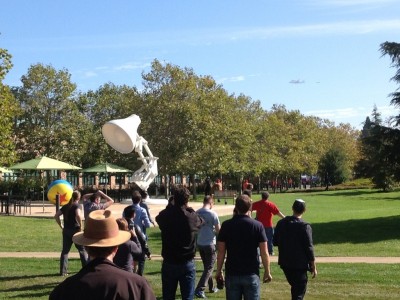I’ve been meaning to write down this story for a while, because it represents a time when I was booed away from a microphone by a crowd of two thousand people, and I always think that stories like this are fun.
Back in 1996, I attended SIGGRAPH in New Orleans. I remember flying out early and arriving somewhere around 7:00AM and being unable to check into my hotel room, so I went down to the French Quarter and had beignets and coffee. It was a wonderful city for one of my favorite activities: eating. Pixar alumnus and foodie Steve Upstill had given out a list of restaurants in New Orleans for me to try, and I don’t think I had a bad meal the entire week. From gumbo to po’boy sandwiches, it was all amazing and delicious.
But back to the conference..
There was a panel that I attended called “Graphics PCs will Put Workstation Graphics in the Smithstonian”. The panelists were:
- Sam Uselton, from MRJ, Inc. served as organizer.
- Michael Cox, from S3
- Jay Tayborg, from Microsoft
- Michael Deering, from Sun Microsystems
- Kurt Akeley, from SGI
It was an interesting discussion, with the first two taking the the side of PCs, and the second two, standing up for the workstations. I had been working in scientific visualization at Princeton, and had then been at Pixar for about five years. My own opinions were that economies of scale would eventually destroy the workstation market. I had worked with high end SGI products, as well as workstations such as Stellar/Ardent/Stardent but had also been tracking the developments in the game world, and to me the writing on the wall was clear.
I remember approaching the microphone and asking a question like “Given what we’ve seen with Moore’s law and the increase in capabilities in microcomputers, and the increasing availability of operating systems like Linux and BSD-based systems,isn’t it reasonable to conclude that the same kind of thing will happen in the graphics market?”
I recall that Akeley and Deering tried to answer with something along the lines of “only workstations have the fast buses/high performance memory subsystems/careful and accurate rasterization that is necessary to do real graphics. I didn’t find that answer particularly helpful and tried to ask a followup and…
Was enthusiastically booed away from the microphone. It was really impressive, to have a couple of thousand people heckle you at once.
But in the end… I think that history points out that I was more or less correct. By no means did I contribute to this trend, but I did recognize it at the time, in a way that the majority of professionals at SIGGRAPH largely did not.
1995 was the apex for SGI, with a market cap of over 7 billion dollars. Ten years later, it was delisted from the NYSE because its stock price had fallen to below one dollar, with a market cap of just $120 million dollars. It was effectively bankrupt in 2006.
Sun would take a different path, riding the dot.com bubble up with its server hardware into the year 2000, and then riding it down to destruction. It never really became a big player in graphics.
Meanwhile, nVidia was formed in 1993 by Huang, Malachowsky and Priem (from AMD, Sun Micro and Sun Micro, respectively). In 1999 they released their Geforce board, which brought hardware with a full transform and light pipeline to the consumer market. They would absorb many other players, and became the destination for a lot of talent who had previously been at SGI. It currently has a market cap of about $18.6 billion dollars.
Mind you, nVidia didn’t pursue a strategy driven entirely by consumer products, and Sun and SGI failed not just because of their graphics strategy. But I do think that I what I said was mostly right, and it didn’t take forever for my prediction to come true.

